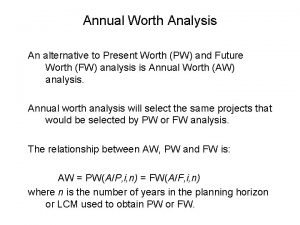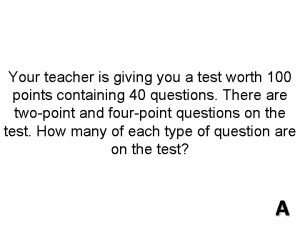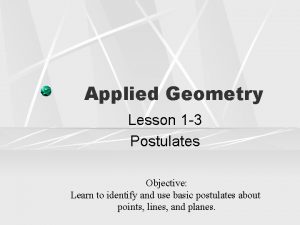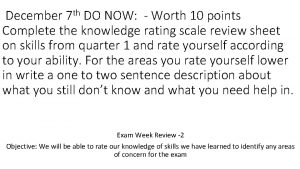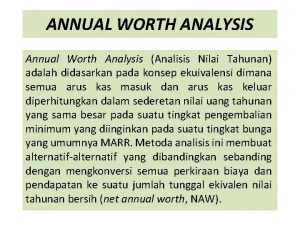Do Now worth 30 points 1 Name the


















- Slides: 18

Do Now (worth 30 points) • 1. Name the two divisions of the structural NS • 2. Name the two divisions of the functional division • 3. Name the two divisions of motor division • 4. Name the two divisions of the autonomic NS

Classification of Nervous System Structural Peripheral NS Functional Sensory/Afferent Division Efferent Division Central NS Autonomic NS Parasympathetic Somatic NS

Today’s Topic • Structure of the Neuron Cell

Creed: • Today I will hold myself and my peers to high expectations. I will show grit and not give up so that I can become a critical thinker. I will advocate for my education, show integrity, and respect my peers, this space and myself.

Objective • SWBAT describe the general structure of a neuron and name its important anatomical regions. • SWBAT communicate labs through RERUN outline

Writing Conclusions to our Lab Reports • Restate: Restate the lab experiment. Describe the assignment. • Explain: Explain the purpose of the lab. What were you trying to figure out or discover? Talk briefly about the procedure you followed to complete the lab. • Results: Explain your results. Confirm whether or not your hypothesis was supported by the results. • Uncertainties: Account for uncertainties and errors. Explain, for example, if there were other circumstances beyond your control that impacted the experiment. • New: Discuss new questions or discoveries that emerged from the experiment.

In Our Results Section • Use the sentence starter… • Based off the data collected it can be concluded that _____

Let’s See an Example • We are going to read over this example and compare it to what we currently have

So what we have been practicing will be in the results section • Based on the data we collected it can be concluded that…. • Now going to shift away from 3 rd person writing such as “I” or “We” so when writing only refer back to your or what was conducted

Time to Practice • First going to have a chance to re-write your own conclusion • Then you will have a peer look at it

Universal Properties of Neurons 1. Excitability- they have the ability to respond to environmental changes called stimuli. 1. Conductivity- Neurons respond to stimuli by producing traveling electrical signals that quickly reach other cells at distant locations. 1. Secretion- When the electrical signal reaches the end of a nerve fiber, the neuron usually secretes a chemical called a neurotransmitter that crosses the gap and stimulates the next cell.

Functional Classes of Neurons • Sensory (afferent) neurons are specialized to detect stimuli such as light, heat, pressure, and chemicals, and to transmit information about them to the CNS. • These neurons can begin in almost any organ of the body but always end in the brain or spinal cord.

Functional Classes of Neurons • Interneurons lie entirely within the CNS. • They receive signals from many other neurons and carry out integrative function of the nervous system- that is, they process, store, and retrieve information and make decisions about how the body responds to stimuli. • About 90% of human neurons are interneurons.

Functional Classes of Neurons • Motor neurons send signals predominantly to muscle and gland cells, the effectors that carry out the body’s responses to stimuli. • They are called motor neurons because most of them lead directly to muscle cells.

Structure of a Neuron • The control center of the neuron is its soma, or cell body. It has a single, centrally located nucleus with a large nucleolus. • The soma of a neuron usually gives rise to a few thick processes that branch into a vast number of dendrites. These are the primary sites for receiving signals from other neurons. Some neurons only have one dendrite, others have thousands. The more dendrites a neuron has, the more information it can receive from other cells and incorporate into its decision-making. As tangled as the dendrites may seem, they provide exquisitely precise pathways for the reception and processing neural information.

Structure of a Neuron • From the other end of the cell body stems the axon, or nerve fiber. It is specialized for rapid conduction of nerve signals to points remote from the soma. It is cylindrical and relatively unbranched for most of its length. A neuron never has more than one axon, and some neurons in the retina and brain have none. Axons range from a few millimeters to more than a meter long! • At the end of the axon are synaptic knobs, from which the neurotransmitter (usually ACh) is released into the synaptic cleft. • The axon itself is wrapped by Schwann cells, which we will talk about more tomorrow; today, its important to know that these protect and insulate the nerve. • The space between Schwann cells is called the Node of Ranvier.

CFU

Practice Extended • Quick Check questions from pg. 387 • 4 -7
 Anything worth doing is not necessarily worth doing well
Anything worth doing is not necessarily worth doing well Annual worth method
Annual worth method Present worth vs annual worth
Present worth vs annual worth Gabby and sydney bought some pens and pencils
Gabby and sydney bought some pens and pencils Answers for books on accelerated reader
Answers for books on accelerated reader Now i see it now you don't
Now i see it now you don't Name all rays
Name all rays Straddle positioning
Straddle positioning Point of difference and point of parity
Point of difference and point of parity Name all the points
Name all the points Name all the points
Name all the points Postulate 1-3
Postulate 1-3 Hát kết hợp bộ gõ cơ thể
Hát kết hợp bộ gõ cơ thể Frameset trong html5
Frameset trong html5 Bổ thể
Bổ thể Tỉ lệ cơ thể trẻ em
Tỉ lệ cơ thể trẻ em Voi kéo gỗ như thế nào
Voi kéo gỗ như thế nào Tư thế worms-breton
Tư thế worms-breton Chúa sống lại
Chúa sống lại


